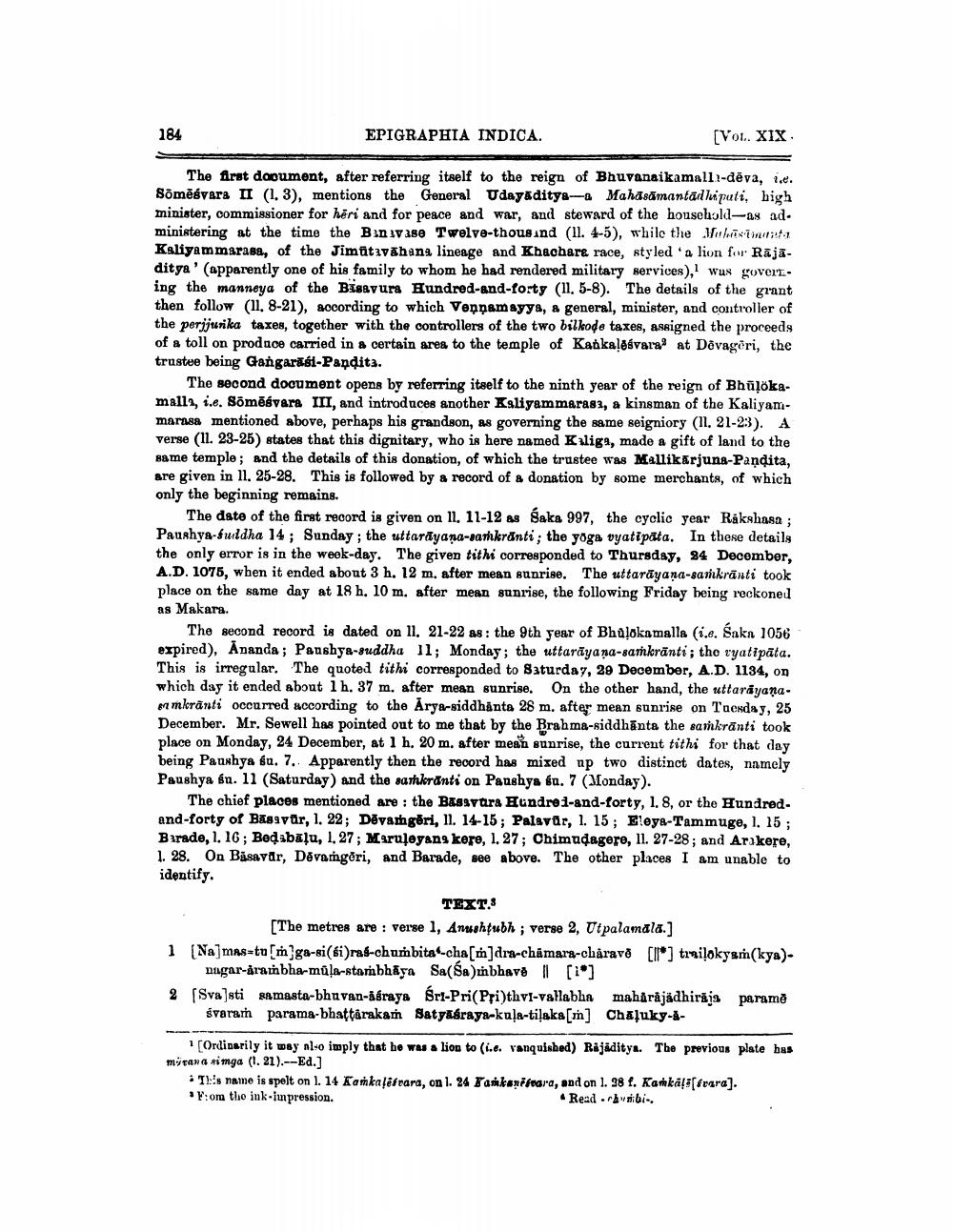________________
184
EPIGRAPHIA INDICA.
[VOL. XIX.
The first document, after referring itself to the reign of Bhuvanaikamalli-deva, i.e. Soměévara II (1.3), mentions the General Udayaditya-a Mahasamantadhipati, high minister, commissioner for heri and for peace and war, and steward of the household-as administering at the time the Binivase Twelve-thousand (11. 4-5), while the Maksimanta Kaliyammarasa, of the Jimatavahana lineage and Khachara race, styled 'a lion for Rajāditya' (apparently one of his family to whom he had rendered military services), was govern ing the manneya of the Bisavura Hundred-and-forty (11. 5-8). The details of the grant then follow (11, 8-21), according to which Vennamayya, a general, minister, and controller of the perjjunka taxes, together with the controllers of the two bilkode taxes, assigned the proceeds of a toll on produce carried in a certain area to the temple of Kankale vara at Devageri, the trustee being Gangarasi-Pandita.
The second document opens by referring itself to the ninth year of the reign of Bhülökamalla, i.e. Somesvara III, and introduces another Kaliyammarasa, a kinsman of the Kaliyammarasa mentioned above, perhaps his grandson, as governing the same seigniory (11. 21-23). A verse (11. 23-25) states that this dignitary, who is here named Kaliga, made a gift of land to the same temple; and the details of this donation, of which the trustee was Mallikarjuna-Pandita, are given in 11. 25-28. This is followed by a record of a donation by some merchants, of which only the beginning remains.
The date of the first record is given on 11. 11-12 as Saka 997, the cyclic year Rakshasa; Paushya-fudha 14; Sunday; the uttarayana-samkranti; the yoga vyatipata. In these details the only error is in the week-day. The given tithi corresponded to Thursday, 24 December, A.D. 1075, when it ended about 3 h. 12 m. after mean sunrise. The uttarayana-samkranti took place on the same day at 18 h. 10 m. after mean sunrise, the following Friday being reckoned as Makara.
The second record is dated on 11. 21-22 as: the 9th year of Bhalokamalla (i.e. Saka 1056 expired), Ananda; Paushya-suddha 11; Monday; the uttarayana-samkranti; the ryatipata. This is irregular. The quoted tithi corresponded to Saturday, 29 December, A.D. 1134, on which day it ended about 1 h. 37 m. after mean sunrise. On the other hand, the uttarāyaṇasmkranti occurred according to the Arya-siddhanta 28 m. after mean sunrise on Tuesday, 25 December. Mr. Sewell has pointed out to me that by the Brahma-siddhanta the samkranti took place on Monday, 24 December, at 1 h. 20 m. after mean sunrise, the current tithi for that day being Paushya su. 7. Apparently then the record has mixed up two distinct dates, namely Paushya su. 11 (Saturday) and the samhkranti on Paushya su. 7 (Monday).
The chief places mentioned are: the Basavara Hundred-and-forty, 1. 8, or the Hundredand-forty of Basavar, 1. 22; Devamgeri, 11. 14-15; Palavar, 1. 15; Eleya-Tammuge, 1. 15; Barade, 1. 16; Beḍabalu, 1, 27; Maruleyana kere, 1. 27; Chimudagere, 11. 27-28; and Arakere, 1. 28. On Basavar, Devaṁgori, and Barade, see above. The other places I am unable to identify.
TEXT.S
[The metres are: verse 1, Anushṭubh; verse 2, Utpalamālā.]
1 [Na]m-tn[th]ga-si(i)ra-chumbita-cha[m]dra-châmara-chárave [] trailokyah(kyn)
nugar-arambha-mūļa-stambhaya Sa(Sa)mbhave || []
2 [Svasti samasta-bhuvan-äéraya Sri-Pri(Pri)thvi-vallabha mahārājädhiraja parame svaram parama-bhaṭṭarakam Satyaáraya-kula-tilaka [m] Chaluky-a
1[Ordinarily it way also imply that he was a lion to (i.e. vanquished) Räjäditya. The previous plate has mirana simga (1. 21).--Ed.]
This name is spelt on 1. 14 Kamkalisvara, on 1. 24 Kamkaniseara, and on 1. 28 f. Kamkali[svara]. F:om the ink-impression.
Read-chibi-.




